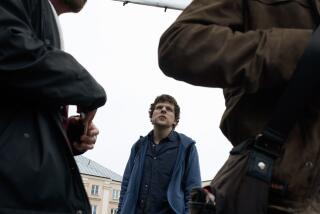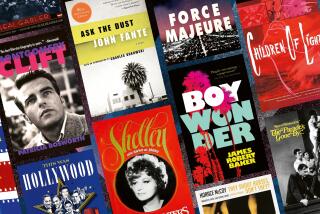Review: Hanns Eisler opera at Stanford reopens the book on a blacklisted Hollywood composer
PALO ALTO — At the moment when tech mammoths Amazon, Apple and Netflix are reinventing Hollywood, the U.S. premiere at Stanford University of “Hell’s Fury, the Hollywood Songbook” Saturday night might seem a bit rich. Hanns Eisler’s songs, written during Hollywood’s supposed golden age, most with texts by Bertolt Brecht, do an excellent job of encapsulating the vision of a newly capitalized silicon-age Hollywood.
Eisler was unlike other notable émigré composers who, having seen their dreams destroyed by the Nazi nightmare, played a crucial role in turning Hollywood into the kind of dream machine it became. Without their atmospheric, embracing, romantic film scores, the early sound movies never would have had the dramatic effect they did, and still do. It was almost as if this is what the likes of Erich Korngold and Franz Waxman and, later, Miklós Rózsa, were always meant to be.
Out of step with the great progressive musical march of Stravinsky, Schoenberg and Bartók, these populist émigrés looked back to the 19th century. Eisler, on the other hand, was a student of Schoenberg in Berlin, and his populism was political. He shared his close friend Brecht’s Marxist sensibility. All art for them had a social responsibility to reach the masses.
The “Hollywood Songbook” was essentially a folder containing songs that Eisler wrote between 1942, when he arrived in L.A., and 1948, when he was deported to East Germany, accused of being a Communist agent by the House Un-American Activities Committee. A good many of the texts were by Brecht. They represent Eisler’s moods as well as his and Brecht’s deeply conflicted attitude about living in Santa Monica, which they felt was both paradise and prison.
Billed as a kind of opera, the production had a program cover that depicted the Hollywood sign but with letters spelling “Hell’s Fury.” British opera director Tim Albery used a number of the songs to chronicle Eisler’s career from its start in Berlin to his exile in Denmark, New York and L.A., and finally to his return to East Berlin after the war, where Brecht joined him. The premiere was last summer at the Luminato Festival in Toronto.
The setting is a recording studio, with baritone Russell Braun and pianist Serouj Kradjian dressed alike in 1940s three-piece suits, both portraying Eisler. Through projections, the studio (first in Nazi Germany) becomes many locales. There is an owl for Denmark. Palm trees turn it into Santa Monica. The Los Angeles Times front page of May 8, 1945, proclaims “VICTORY.” By the end, the studio is littered with wine bottles, cigarette butts, an espresso pot. That is the kind of life Eisler led.
If “Hell’s Fury” is an opera, it is a documentary opera. Braun proves a convincing Eisler, who narrates the composer’s life in first person. The songs are chosen to give poetic context but mainly express mood and emotion. Kradjian is more alter ego, the pianist appearing to write the songs as they were being performed.
And, yes, there is hell and there is fury. Eisler carries a radio to chart, through the news, his worst fears in “To a Portable Radio,” a song so tuneful it long stays with you. Withering irony is bread and butter to Brecht, who claimed that Eisler was his best reader, the composer who best caught his essence. In “The Son,” a teenager is told he hardly needs to study English when rubbing one’s belly will be readily understood.
L.A. was a place of angst for Eisler, and the recording studio turns into a bar. He scored eight Hollywood films, mainly for the money, but also because he developed theories about how music and film might work together to create a new art form. Eisler’s scores for Fritz Lang’s “Hangmen Also Die!” and “None but the Lonely Heart” received Oscar nominations. He spent much time with the likes of Schoenberg (whom he continued to lionize) and Charlie Chaplin (whom Brecht lionized) and arguing with émigré writers Theodor Adorno and Thomas Mann.
Although his songs and film scores had their charming populist elements, Eisler didn’t give up his more modernist 12-tone tendencies, and the bleeding of two extremes could lead to powerful forms of expressionism. But the extremes also tore him apart emotionally, and he didn’t need Brecht’s anti-capitalist bitterness to come up with his own. “The only thing which consoles us for our miseries,” Eisler wrote in an English language lyric for one of his bleak songs, “is diversion, and yet this is the greats of our miseries … diversions amuse us and lead us unconsciously to death.” You can only imagine the bad-mood songs Eisler would have written about the bottomless moneybags behind streaming.
He left America outraged, noting that his incontrovertible HUAC witch hunt represented “fascism in its most direct form.” Back in East Germany, Eisler fit in at first. He wrote the country’s snappy national anthem and was put on a postage stamp. But he found only repression there as well, especially in the restrictions on musical style and expression.
Over a tight 70 minutes, “Hell’s Fury” gives a useful summary of Eisler’s situation. Braun’s is a consistently powerful performance. Outbursts are frequent, though most touching are the quieter, more desperate moments. Kradjian is an intimate pianist. Surtitles were imaginatively projected for the songs in German but not for those sung in Albery’s English translations, and too much of Brecht’s poetry was lost.
The audience in the Bing Concert Hall for this admirable presentation by Stanford Live was small Saturday (following a Friday night performance) and clearly attracted little of the Silicon Valley and student crowd that overflowed Palo Alto restaurants on a weekend night. But “Hell’s Fury” knows no bounds. Sending it south would make sense. A soundstage at a Culver City studio might be a suitable venue, don’t you think?
More to Read
The biggest entertainment stories
Get our big stories about Hollywood, film, television, music, arts, culture and more right in your inbox as soon as they publish.
You may occasionally receive promotional content from the Los Angeles Times.











